Tuk Tuk Tours
Explore Bangkok by the iconic tuk tuk
Western Thailand is often a bit of an afterthought in visitors’ minds, bundled in alongside the more clearly defined central, northern, eastern and southern regions. But a number of Thai provinces don’t quite fit that neat method of dividing up the country, jutting out as they do towards the border with Myanmar. That’s not to say they’re not worth visiting – in fact, Thailand’s western provinces include a few hotspots that attract hordes of tourists every year, along with a number of quieter hideaways that you might just have to yourself.
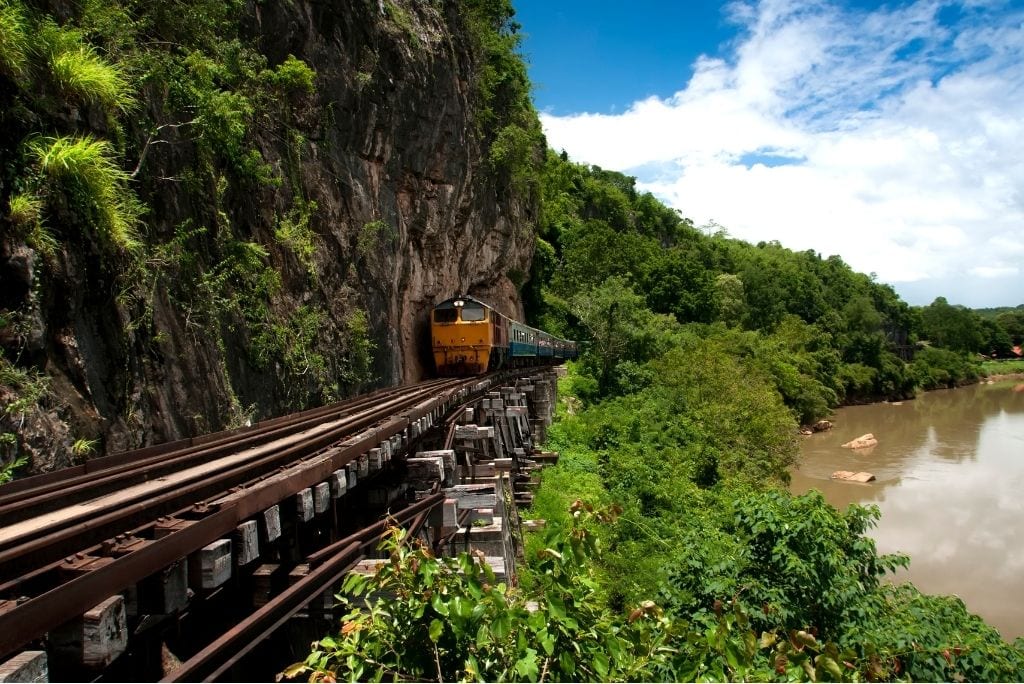
Among western Thailand’s most visited destinations, Kanchanaburi is full of tourism attractions. From sobering prisoner-of-war cemeteries and evidence of World War Two’s Death Railway (like the Bridge Over the River Kwai itself and the even more evocative Hellfire Pass) to more light-hearted escapes like the seven-tiered Erawan waterfalls.
Kanchanaburi is only a couple of hours north-west of Bangkok. For a more pleasant and memorable journey, it’s easily reached by train from the capitals Thonburi railway station. Hiding away with a book and a hammock on a picturesque raft house along the River Khwae is a fabulous way to spend a weekend of seclusion in Kanchanaburi. Whether you do it from the touristy Maenam Khwae Road in Kanchanaburi city itself or instead opt for one of the truly secluded and undeniably stunning out-of-town spots.
Kanchanaburi is also a notoriously inexpensive place to holiday. With everything from its dirt-cheap accommodation options to bars selling shots of local (branded) whisky for as little as 10 baht plotting to keep you in the province for longer than you had planned.
There are frequent minivan and air-conditioned bus departures for Kanchanaburi from Bangkok’s northern Mo Chit terminal and southern Sai Tai Mai terminal. Alternatively, take one of the two daily departures by local, fan-cooled train from Bangkok’s Thonburi railway station (note that non-Thais are charged a flat rate of 100 baht for the journey on this route, while the fare for Thai nationals between Thonburi and Kanchanaburi is 25 baht). On weekends, you can also catch an excursion train to Kanchanaburi. It leaves in the early morning from Bangkok’s main Hualamphong railway station. It returns the same evening. But you can easily skip the return leg if you’re planning on spending a few nights in Kanchanaburi.
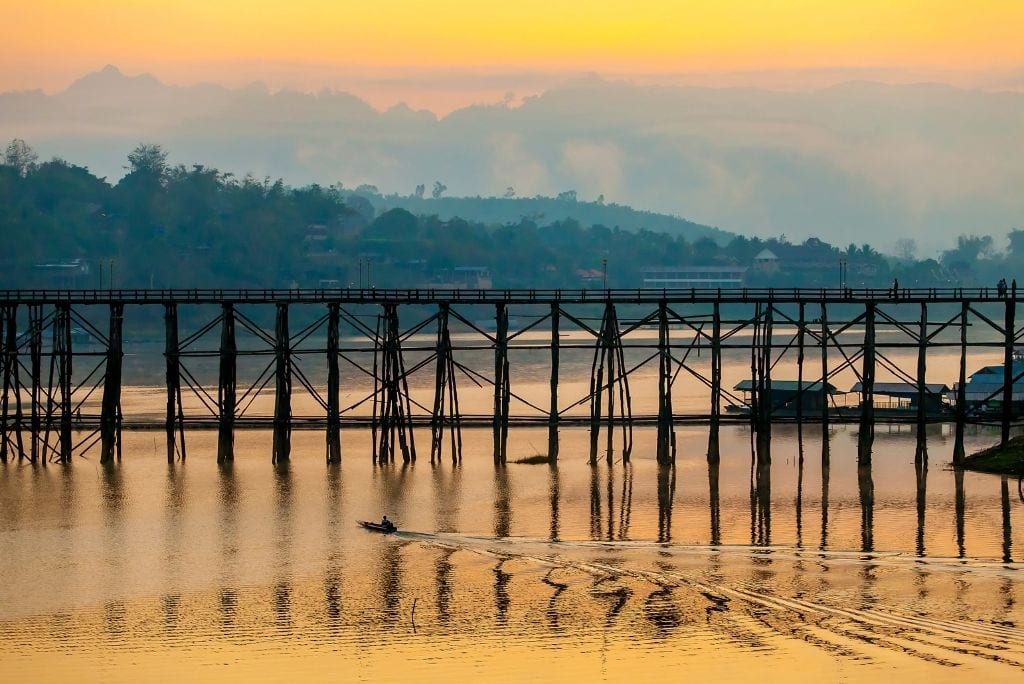
Also located in Kanchanaburi province, but much further out to the remote west and just 12km from the border with Myanmar. Sangkhlaburi is a stunning, secluded, and culturally diverse outpost of a town. It is best known for a photogenic wooden bridge – the longest handmade bridge of its kind in Thailand stretching over the area’s enormous man-made lake.
As much as anything, Sangkhlaburi is the kind of place perfect for just hanging out, kicking back, and relaxing for a few days. Or potentially slightly longer than anticipated. But there are also stunning Buddhist temples like Wat Wang Wiwekaram to discover close by. While taking a boat ride out across the famous lake gives you the chance to discover the remains of old Sangkhlaburi town, sunken to create a dam. The village of Mon settlers, on the opposite side of the bridge from Sangkhlaburi proper, is also worth a visit.
From Kanchanaburi city’s main bus terminal, minivans, air-conditioned buses and local fan-cooled buses make regular daily trips to Sangkhlaburi. The trip takes around three and a half to four hours. There are also two daily direct buses from Bangkok’s Mo Chit bus terminal to Sangkhlaburi, taking around seven hours.
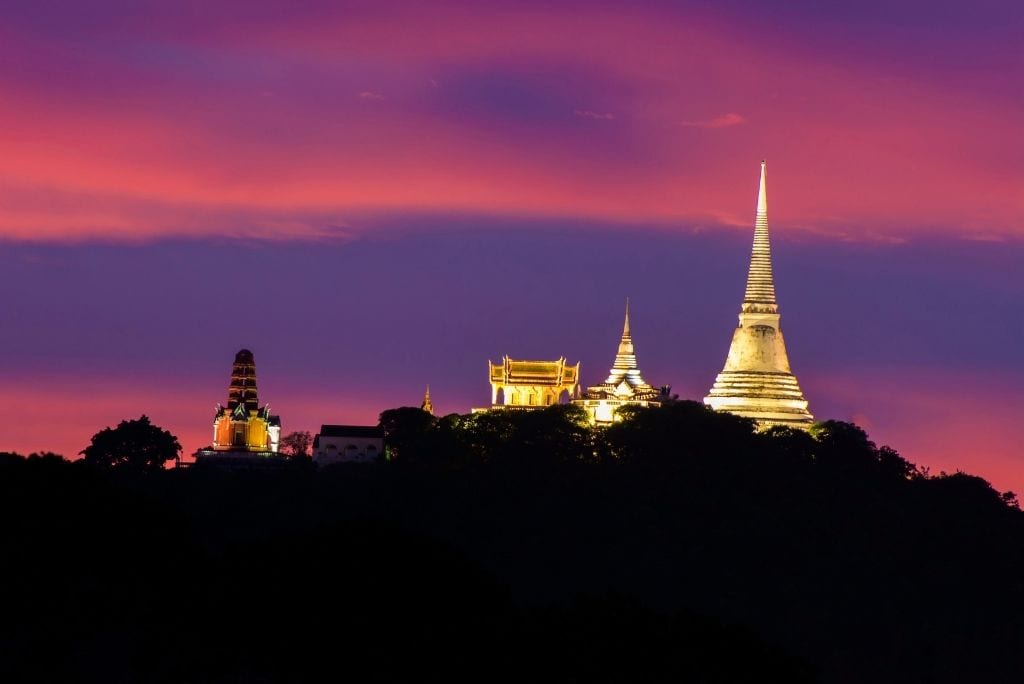
Though it’s still further north than Hua Hin or Prachuap Kiri Khan proper, Phetchaburi province is arguably the point on your journey from Bangkok that you begin to get a taste for the flavours of southern Thailand. As the landscape begins to transform and the vibe slowly changes.
Phetchaburi is a low-key, non-touristy and historically significant city and province. And also one that’s great for foodies. It has a strong food game going on all around, but it’s especially famous for its collection of sweet treats like Kanom Mor Gaeng custard-based dessert and Khao Tang – crispy pork-based crackers.
The hilltop royal palace of Khao Wang, officially known as Phra Nakhon Kiri Historical Park, is among Phetchaburi’s most picturesque attractions and definitely worth a visit. While beaches like Had Chao Samran (and even Cha-am, towards the south of the province) mean Phetchaburi also delivers for beach-lovers.
13 trains run from Bangkok’s Hualamphong station to Phetchaburi each day. With a journey time of around four to five hours. Buses and minivans run from both the northern Mo Chit and southern Sai Tai Mai terminals in Bangkok to Phetchaburi, taking around three hours.
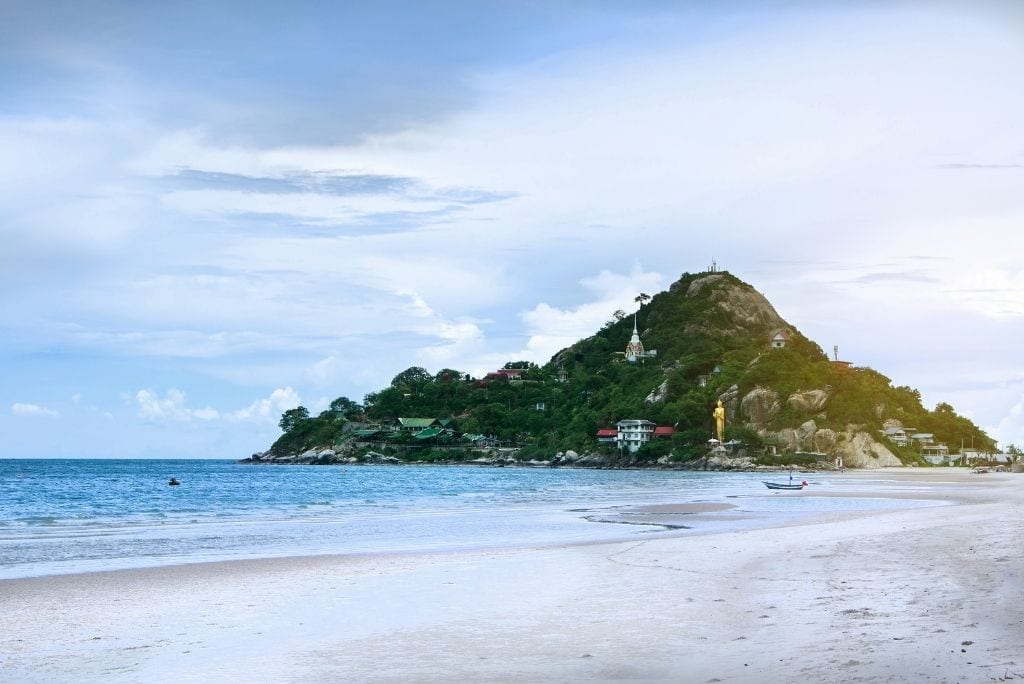
Though it’s often grouped together with provinces in southern Thailand, the resort town of Hua Hin – and indeed the rest of Prachuap Kiri Khan province, of which it forms a part – is both geographically more connected to and has more in common with the country’s western region than the true southern provinces further down the coastline.
Hua Hin is a favourite getaway for Bangkokians looking to escape the capital for the weekend without having to contend with a lengthy drive. There are glorious white-sand beaches, impressive views from the likes of Khao Takiab mountain. And a delicious array of inexpensive seafood and other Thai food to enjoy. As well as a growing scene of trendy and high-quality coffee shops.
Hua Hin is also well equipped with a diverse hotel scene. Therefore, it’s easy to find somewhere comfortable to stay that suits your budget.
The road journey from Bangkok to Hua Hin takes around four hours; buses and minivans depart at regular intervals throughout the day from Bangkok’s southern Sai Tai Mai terminal. The train from Bangkok’s Hualamphong Station is also a pleasant way to make the journey. There are 13 departures throughout the day, and the ride takes between four and five hours. Hua Hin also has an airport, but currently, there are only regular flights to and from Kuala Lumpur with AirAsia.
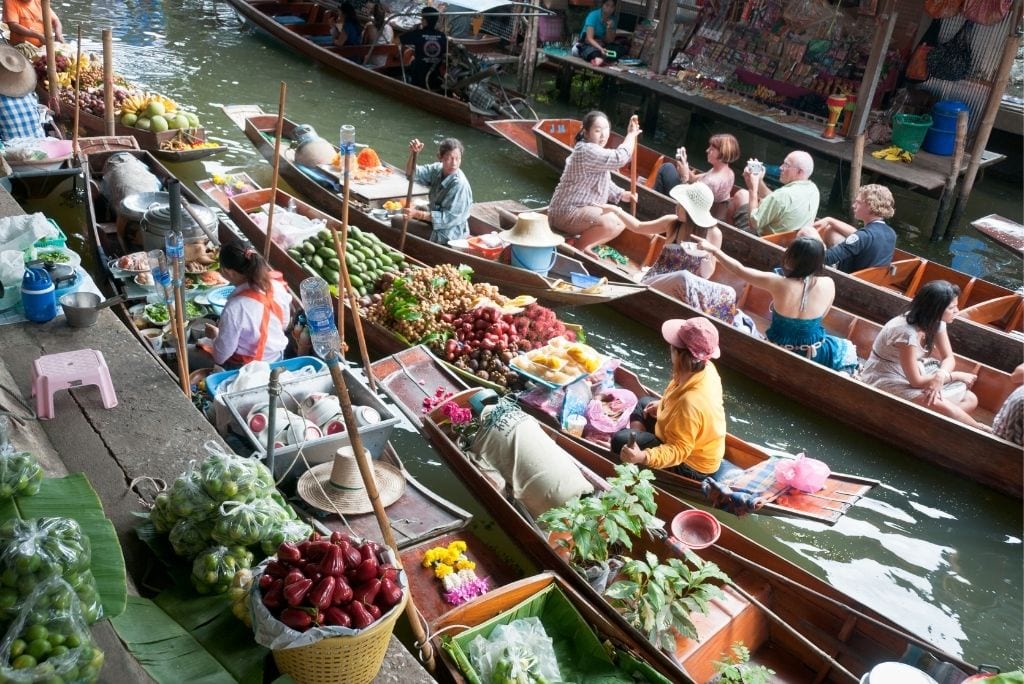
Ratchaburi is most famous for being home to Damnoen Saduak floating market. However, it’s a province that’s also worth visiting for other reasons.
Wat Khao Chongpran temple is worth a visit for a sight of the cave next to it. From where thousands of bats pour out into the sky around dusk every evening. Looking like a stream of smoke, as they do, it’s just the sight to behold.
Elsewhere, Suan Pheung district is another popular part of Ratchaburi. With natural attractions like hot springs alongside a range of theme-park-style attractions and accommodation options like sheep farms and resorts designed to imitate the Greek landscape. In other words, the kind of things you’ll find either impressive or just outright strange.
The train makes for a convenient way to get from Bangkok to Ratchaburi. There are 13 daily departures taking between two and two and a half hours. Alternatively, buses and minivans depart regularly from Bangkok’s southern Sai Tai Mai terminal and take around an hour and a half.
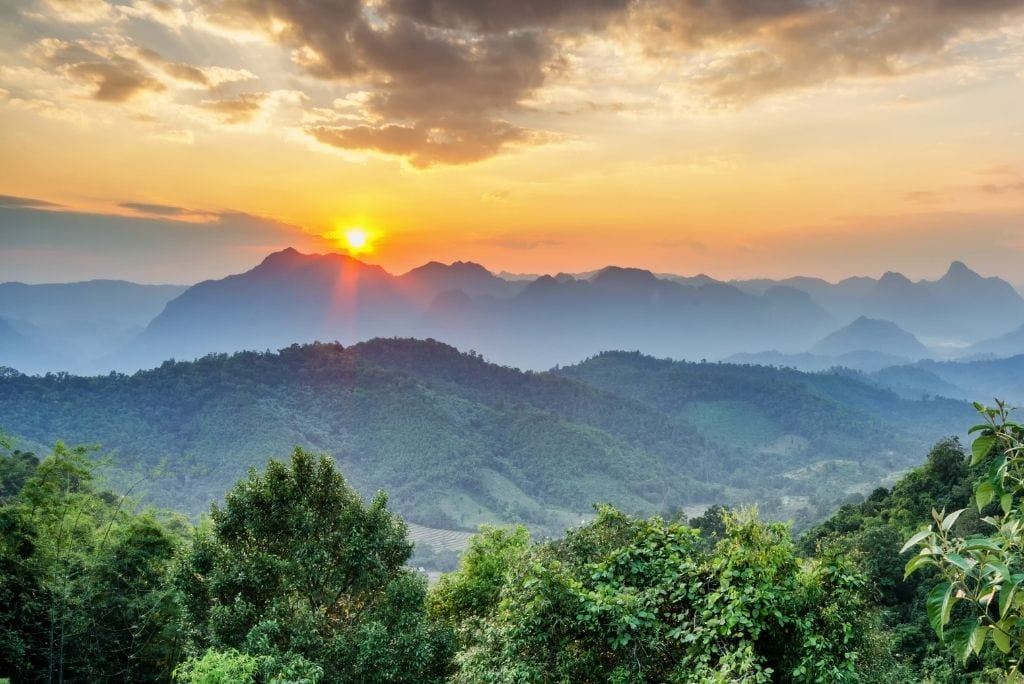
Tak is geographically better associated with the country’s western region, nestled up against the Burmese border as it is. And given that it isn’t quite as far up north as neighbouring provinces like Mae Hong Son.
There’s admittedly not heaps going on in the provincial capital itself. But it’s nevertheless an interesting spot that will appeal to those looking to knock off a few lesser-visited Thai provinces. Given its decidedly low-key nature, Tak city is also a great place to settle in and simply relax for a while.
For something more invigorating and culturally immersive, Mae Sot city an hour or so further out towards the Burmese border is a bustling melting pot that’s also a great place for eating. While there are temples to see in the city itself and temples, waterfalls, and more within close enough distance to render them easily reached on a day trip.
Buses depart for Tak regularly throughout the day from the northern Mo Chit terminal in Bangkok. It takes around seven hours. Alternatively, make the five-to-nine-hour journey by train from Bangkok’s Hualamphong station to Phitsanulok. Or fly there in around an hour with AirAsia, Lion Air, or Nok Air from Bangkok’s Don Muang airport. And then take one of the regular bus or minivan departures for the remaining 90-minute journey to Tak. Finally, Bangkok Airways flies from Bangkok’s Suvarnabhumi airport to Sukhothai in around an hour and 20 minutes, from where it’s about a 90-minute minivan or bus ride to Tak with regular departures.
Where are your favourite spots in western Thailand? Let us know in the comments!
At Expique our mission is to help people discover the real Bangkok (and beyond) and the local cultures. We do this through a combination of offering our own award winning tours and through producing informative content.
Our range of experiences in Bangkok including our award winning Bangkok Night Lights Tuk Tuk Tour and our foodie extravaganza Evening Food & Tuk Tuk Adventure.
Subscribe to our newsletter to receive monthly news and tips about exploring Bangkok.